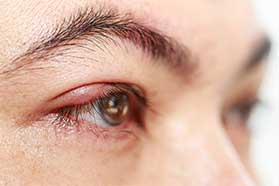Blepharitis Treatment

Blepharitis is a common yet chronic condition which creates eyelid inflammation, redness and irritation due to oily particles and bacteria coating the eyelid at the base of your eyelashes or the inner edge of the eyelid.
There are two types of blepharitis:
- Anterior blepharitis: The outer part of the eyelid where your eyelashes attach is affected by a bacterial (or viral) infection.
- Posterior blepharitis: The eye’s Meibomian glands that produce oil become clogged, which may contribute to stye formation or cause the edges of the eyelids to thicken and form crust.
Blepharitis treatment usually involves the management of symptoms. Its cause is not well understood, but it has been associated with the occurrence of bacterial eye infections, dry eyes or conditions like rosacea and dandruff. Ointments, eye drops and oral medications—including antibiotics and steroids—are often used, but there are also holistic approaches or natural remedies that can alleviate symptoms.
To schedule a consultation with a healthcare provider in Bedford that specializes in blepharitis treatment, call (817) 203-2760 or contact Ms. Jessica Stangenwald online.
Blepharitis Symptoms
While inflammation (swollenness) is a key indication you may be suffering from blepharitis, it is not the only sign. In addition, blepharitis symptoms include:
- A feeling that something is in your eye
- Redness of eye or edge of eyelid
- Crusting of eyelid or eyelashes
- Itchiness, stinging, burning or irritation
- Continual tearing
Blepharitis Causes
Depending upon the type of blepharitis you have, the cause may vary. While everyone has bacteria on the skin, sometimes this bacteria can accumulate at the base of the eyelid and cause much discomfort. In these cases of anterior blepharitis, a bacteria such as Staphylococcus is often to blame. Other possible anterior blepharitis causes include dandruff on the scalp or eyebrows (seborrheic dermatitis), an allergic reaction or even eyelash mites.
On the other hand, posterior blepharitis can occur due to an irregular oil production in the Meibomian glands. Some researchers postulate a lack of omega-3 fatty acids in the diet may contribute to malfunction of the oil glands at the base of the eyelashes. Posterior blepharitis can also stem from other skin conditions like dandruff, rosacea and acne.
Blepharitis Treatment Options
Your healthcare professional can diagnose blepharitis after a comprehensive eye examination in which he or she inspects both the eyelids and the eyelashes. Your healthcare provider may also employ a slit-lamp microscope exam or test your eye pressure as part of the diagnostic process.
Blepharitis treatment is often ongoing and it will be important to carefully take care of your eyes, keeping them clean and dry. The following are the most popular treatments your healthcare provider may recommend:
- Antibiotic ointment
- Artificial or steroid eye drops
- Oral medications
- Warm compresses
- Eyelid scrubs
A natural but therapeutic approach to your blepharitis is often accomplished through nutritional therapy (adding more omega-3 fatty acids into your diet) and applying virgin coconut oil to your eyelids before bed with a heavily diluted drop of tea tree oil. Good hygiene is also vital to the healing process; you will need to regularly clean your eyelids and eyelashes and keep dandruff under control.
If you suspect you have blepharitis, do not postpone treatment; your eye health is key to your overall health! Request more information about blepharitis and your treatment options today. Call (817) 203-2760 or contact Ms. Jessica Stangenwald online.
The New You Medical & Infusion Clinic
Address
100 Grapevine HwyHurst, TX 76054
(817) 203-2760
https://www.newyoumedclinic.com/
Hours
Mon:
10:00 am - 6:00 pm
Tue:
10:00 am - 6:00 pm
Wed:
10:00 am - 6:00 pm
Thu:
10:00 am - 6:00 pm
Fri:
Closed
Sat:
Closed
Sun:
Closed


